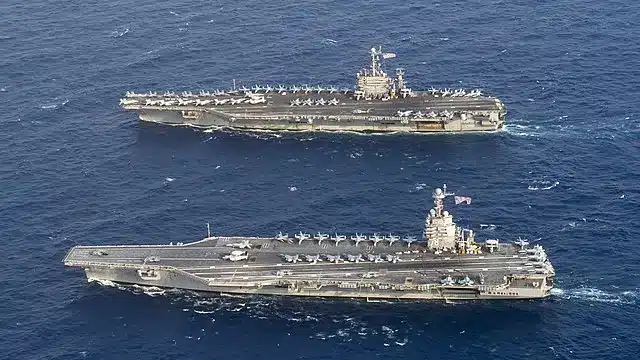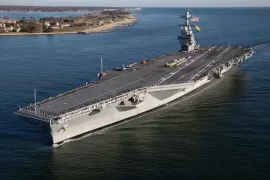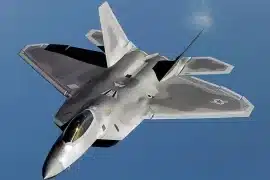Aircraft carriers, often regarded as the kings of the sea, are the epitome of naval power projection. These colossal vessels have played a pivotal role in modern naval warfare, allowing nations to project airpower far beyond their shores. One distinctive feature of some aircraft carriers is the angled runway on their flight deck. In this article, we delve into the reasons behind this design choice and explore the many advantages angled flight decks offer to naval operations.
The Birth of the Angled Flight Deck
During the Cold War, aircraft carriers faced a significant challenge. They needed to quickly launch and recover fighter planes in the event of a confrontation with enemy forces. The conventional straight flight decks posed a problem, as aircraft landing and takeoff operations could potentially collide, leading to catastrophic accidents.
British naval engineers came up with a brilliant solution: an angled flight deck that allowed for simultaneous takeoffs and landings. This groundbreaking idea was first applied to the HMS Triumph in 1948 and was quickly adopted by other navies around the world.
Advantages of Angled Flight Decks
The angled flight deck offers numerous advantages over straight decks, making it an indispensable feature of modern aircraft carriers. Let’s explore these advantages:

1. Efficiency in Operations
The angled flight deck provides unparalleled efficiency during flight operations by separating the landing area from the runway. Aircraft can take off and land independently without interfering with each other, speeding up the flow of planes and enabling carriers to respond rapidly to changing tactical situations.
2. Improved Safety
In the event of a “bolter,” where an aircraft misses the arresting cables during landing, the angled flight deck provides an escape route. The aircraft can take off and attempt another landing without risking catastrophic collisions with parked aircraft. On a straight flight deck, such a situation could have disastrous consequences for both the crew and the equipment.
3. Flexible Flight Operations
The angled flight deck offers unparalleled flexibility during flight operations. With separate takeoff and landing zones, aircraft carriers can adapt to changing conditions, such as weather or tactical situations. This flexibility is crucial for mission success, ensuring carriers are always ready for action, regardless of challenges they may face.
4. Optimal Use of Deck Space
Angled runways make optimal use of limited space on aircraft carriers by separating takeoff and landing areas, utilizing deck space more efficiently. This results in more aircraft being carried on board, enhancing the carrier’s firepower.
5. Faster Aircraft Rotations
Aircraft can land, be resupplied, and take off more quickly on an angled flight deck than on a straight one. These faster rotations enable aircraft carriers to deploy their planes efficiently during missions, ensuring they are always ready to respond to changing situations.
6. Reduced Wear and Maintenance
The angled flight deck leads to reduced wear and maintenance for both aircraft and carriers. Since landing aircraft need to decelerate less rapidly when engaging the arresting cable system, there is less impact on aircraft structures and the deck. This results in lower maintenance costs and longer operational periods without major repairs.
7. Improved Communication and Coordination
The angled runways enhances crew communication and coordination during flight operations. With takeoff and landing areas separated, air traffic controllers can focus on one task at a time, reducing the likelihood of errors or miscommunication. This boosts overall safety and operational efficiency.
8. Increased Firepower and Versatility
The angled flight deck allows aircraft carriers to deploy a wider variety of aircraft and helicopters thanks to its efficient deck layout. Carriers can carry a combination of fighter jets, reconnaissance aircraft, transport planes, and helicopters. This versatility makes the ship a powerful and flexible unit capable of executing a wide range of missions.
Evolution and Future of Angled Flight Decks
Over the years, the angled runways has continued to evolve and be optimized. The introduction of steam catapults in the 1950s allowed heavier jet fighters to take off more quickly. Advanced navigation systems, communication equipment, and safety features have also been installed to enhance flight operations.
In recent years, the electromagnetic aircraft launch system (EMALS) on American Ford-class aircraft carriers has been a major milestone, providing a smoother, more efficient, and reliable launching process for aircraft. Additionally, experimentation with unmanned aerial vehicles (UAVs) on angled flight deck carriers may revolutionize naval aviation in the future.
Summary of ‘Angled Flight Decks’
In conclusion, the angled flight deck is a remarkable innovation that has significantly improved the efficiency, safety, and versatility of aircraft carriers. Its global adoption, influence on carrier design, and impact on civil aviation underscore its importance in modern naval operations. As technology continues to advance, we can expect further enhancements to this crucial component of naval power projection.







